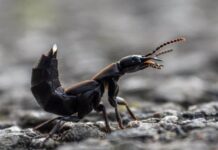When it comes to the largest snail species, it is hard to think of any because we usually see the small ones. The slow and garden-dwelling snails are mostly the gastropods that come up to most people’s minds. However, the largest snail species are rather from another realm. And if you haven’t seen large snails before, some of the species that you are going to see shall impress you.
13Decollate Snail
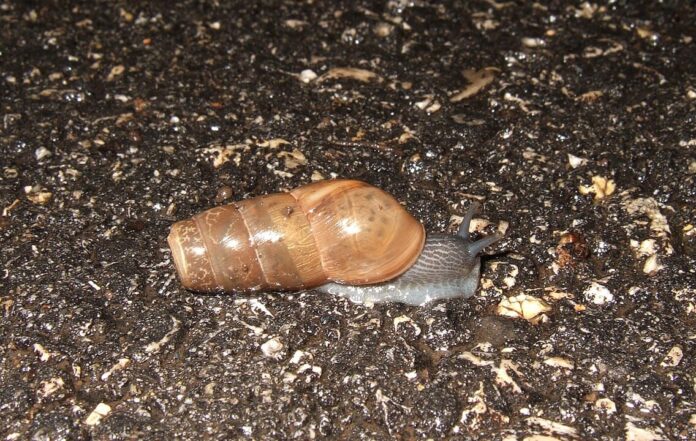
Scientific Name: Rumina Decollata
Size: 4 – 4.5 centimeters
A decollate snail has a strange shell appearance, it is long and roughly cone-shaped. This spiraling shell is elongated and tapered toward the rear, and it is pinkish brown in color. As for the antennae, head, and foot, they are blackish or dark olive-gray. It will chip off or grind the end of its own shell once it reaches the mature size at around 4 centimeters. The snail does so by moving its body roughly against hard surfaces until the shell has a decollate shape; hence the name.
This unique-looking snail is native to the Mediterranean, excluding the southeast Mediterranean and North Africa. Decollate snails live only in and on litter and soil, and they only climb trees to escape heavy rain. We all know that snails are slow but they are one ferocious predators when it comes to preying. As for the decollate snails, they hunt and feed on common garden snails and slugs along with their eggs. At the same time, these gastropods also eat old leaf mulch but they do not eat healthy plants. So if you see one in your garden, don’t worry because your plants are safe. They are most active during the night and in rainfall, and they spend their days burrowing deep into the soil.
12Cuban Land Snail
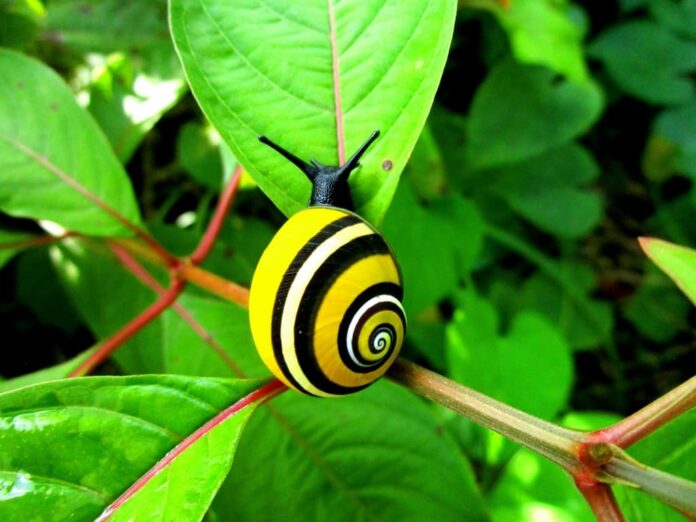
Scientific Name: Polymita Picta
Size: 6 centimeters
While being almost last in the large snail species list, Cuban land snails are one of the most beautiful snails. Look at that eye-catching and bright shell, it looks like as if an artist paints on it. Usually, the colors of the shells are brick red and black, bright yellow with a white stripe, pastel yellow, and more. Their shell colors depend on their diet, and no snails have shells with such a wide range of colors like this.
As the name suggests, these arboreal gastropods are endemic to Cuba, living from the mountains all the way to the coast of the island. They inhabit coastal habitats in the subtropical forests where they climb on barks and leaves of their favorite trees. These beautiful snails eat fungus, lichens, and moss that grow on those barks and leaves. As I always say, beauty comes with consequences. Cuban land snails are so gorgeous they are being collected by poachers to make jewelry and trinkets. This is why they are now endangered.
11Rosy Wolf Snail
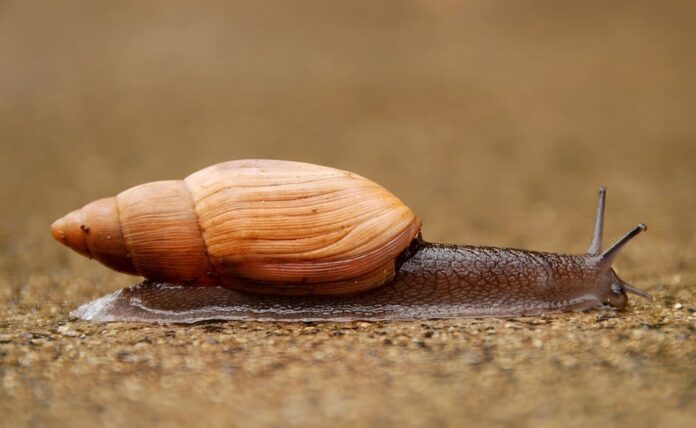
Scientific Name: Euglandina Rosea
Size: 7 centimeters
A rosy wolf snail can reach a length of 7.6 centimeters, and it also has an interesting shell shape. The shape of the shell tapers to a point at both ends, with a narrow oval-to-crescent-shaped opening. Its elongated shell is nearly translucent and brownish-pink while the body is dark wine purplish-brown to light gray in color. The lower tentacles are short and most touch the ground while the two upper tentacles are 3 times longer. They have black eyes at the end of their upper tentacles. On top of that, they also have two oral lappets with chemical receptors that allow them to follow the prey’s slime trails. And speaking of prey, these predators can also hunt tree-climbing snails by following them to tree branches.
It is one of the largest snail species native to the Southeastern United States with a distribution in Florida and Georgia. While most land snails are slow, this one is rather the opposite as they are 3 times faster than most snails. Being both fast and voracious, they hunt and eat slugs and snails, and these cannibalistic snails also feed on other rosy wolf snails and eggs. They use their necks to hold larger prey while sticking an eversible esophagus into the prey’s shell. Then they mince up the prey and suck out the insides of the meal. As for smaller prey, these snails will just ingest them whole. Despite having a lifespan of only around 24 months, they are considered to be invasive species and pests in many places. That is because they are responsible for the extinction of at least 8 native snail species in Hawaii.
10Burgundy Snail
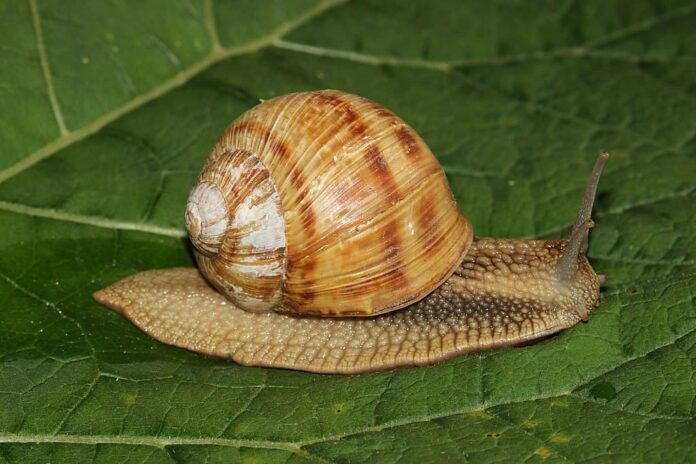
Scientific Name: Helix Pomatia
Size: 10 centimeters
The burgundy snail aka escargot or Roman snail, is an edible land snail species widely known across the world. Its shell is creamy white to light brownish with indistinct brown bands along with 5 to 6 whirls. Some have dark brown and almost black shells with a subtly glossy feature. The width of the shell is 3 to 5 centimeters, and it has a large aperture with white edges. It has two pairs of tentacles on its head; the upper one contains the eyes, and the lower pair has the smell sensors. Another interesting thing about these snails is that they hibernate during winter, and they do it for 6-7 months.
Native to Europe, its distribution is through Central Germany all the way to Serbia, France, Norway, and England. These snails occur in dry fields, forests, meadows, and shrublands, and it is not common to find them in gardens. In fact, they prefer living in moist environments, mostly among plants and vegetation. As herbivores, their diet contains algae, flowers, fruits, fungi, grains, leaves, tree saps, vegetables, and other plant elements. Occasionally, they also consume small dead or injured animals. Just like the name suggests, escargots are very popular in French cuisine. Also, they do have natural predators including birds, centipedes, ground beetles, insects, and mice, but their eggs are the most attacked. However, their population is doing just fine due to the wide distribution and protection across its native range.
9Pink-Lipped Agate Snail
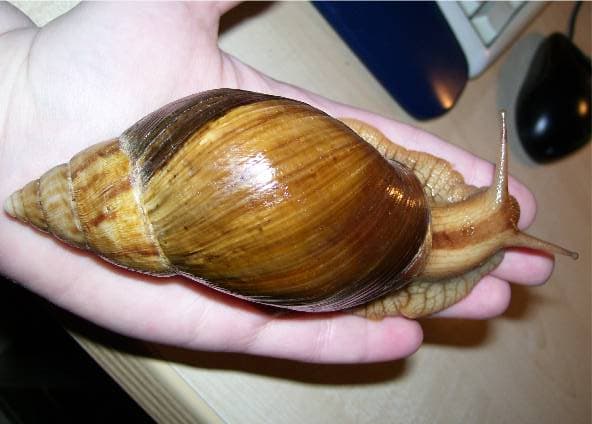
Scientific Name: Achatina Immaculata
Size: 15 centimeters
Growing up to 15 centimeters, it is one of the largest snail species in the world. Adults have a plain brown shell that fades towards the tip, and its body is orangey-brown in color. Pink-lipped agate snails occur in Southeastern Africa, living in areas along the coast where they feed on both decaying matter and plants. Usually, these snails have a diverse diet that includes flowers, fruits, vegetables, and even farmers’ crops like bananas, cauliflowers, cocoa, and peanuts. While some snail species are more common as food, this one is common as a pet. The thing is that these snails are rare, and it is illegal to export them out of Africa because they are endangered. So the ban is to ensure that the wild population is not disturbed so that they can breed.
8Giant Panda Snail
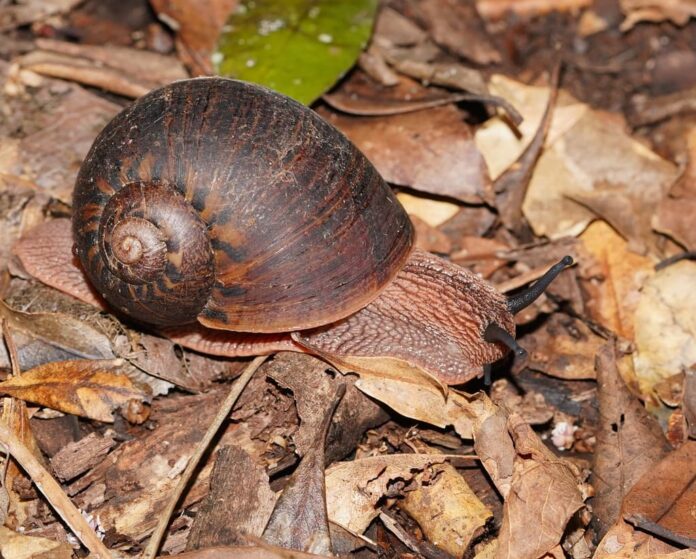
Scientific Name: Hedleyella Falconeri
Size: 17 centimeters
While not being black and white, there is no explanation for where the giant panda snail got its name from. This gastropod can reach a diameter of around 9 centimeters in height and 17 centimeters in length. The color of the shell is some shade of brown along with dark bands and black splotches. Meanwhile, the upper surface of their head and foot has a reticulate pattern in gray while the foot rim is orange. The head of a giant panda snail has two pairs of retractable dark-colored tentacles; looks a bit freaky. Its upper pair is twice longer than the lower and it has eyes on the tips. They can retract their head and foot into the shell when needed, and extend them when they want to move around.
The giant panda snails are the largest land snail species native to the land down under, with a distribution in subtropical eastern Australia. Its range is from Smiths Lake in New South Wales all the way to the north of Brisbane. They live on the forest floor among leaf litter and mossy logs, spending their day stationary or hiding. These snails prefer living under forest debris, logs, or in leaf litter near the bases of fig trees. As the sun goes down, they start to move around and feed on fruiting bodies of fungi and possibly rotting leaves. Being active at night, especially after rain, these snails move around randomly looking for food. Giant panda snails are also popular as pets, and in captivity, they feed on various things such as mushrooms, soft fruits, etc.
7Lissachatina Agate Snail

Scientific Name: Achatina Reticulata
Size: 18 centimeters
Lissachatina agate snail aka tiger snail, is one of the largest snail species from Africa. The shell of these large snails can reach up to 18 centimeters, and it has a distinct reticulated pattern. Some of the bigger ones can reach up to 30 centimeters in length, though quite rare. Its shell has brown, orange, and yellow streaks along with some dark speckling while the flesh is soft brown in color. The combination of the colors and ridges makes it almost like scratches all over their shell.
This African snail species has a native distribution in the coastal region of Zanzibar with some populations in Nigeria also. However, they also have a distribution in parts of Asia, the Americas, and the Pacific as a food source and through the pet trade. As one of the largest snail species, their appetite is also big. They feed on fruits, leaves, and vegetables as well as feces and dead animals or insects. Along with that, they also feed on a wide variety of plants, including crops, and that makes them pests in agricultural areas.
6Giant African Land Snail
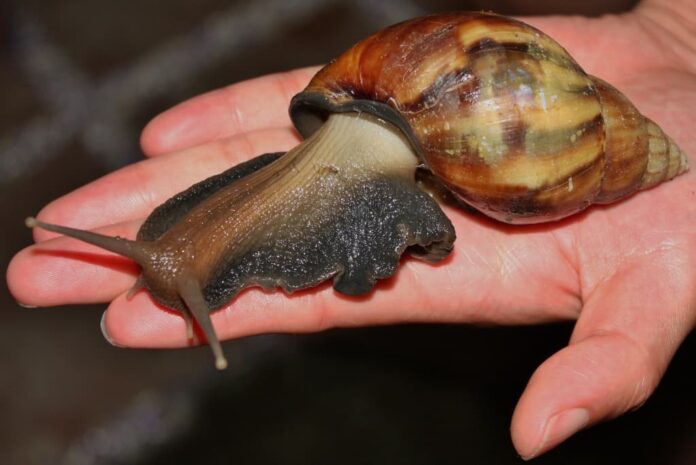
Scientific Name: Achatina Fulica
Size: 20 centimeters
An adult giant African land snail is around 7 centimeters in height, and 20 centimeters or more in length. The shell is reddish-brown in color with 7 to 9 whorls but the body can be either brownish-gray or buttery yellow. Albino ones are also pretty common, with a yellow body and yellow shell. The giant African land snails are native to East Africa, living along the margins of forests with a tropical climate. They also occur in agricultural areas, coastal areas, disturbed areas, riparian zones, urban areas, and wetlands.
While having the title of one of the largest snail species in the world, its reputation is not too good. Giant African land snails are considered pests and an invasive species in many parts of the world. Outside of its range, these snails cause severe damage to agricultural crops and native plants. That’s not all, they also eat ornamental plants like flowers in the garden and more. The worst part is that these snails can also transmit both human and plant pathogens. Negative things aside, these snails are useful as a medicinal and protein source.
5Giant West African Snail
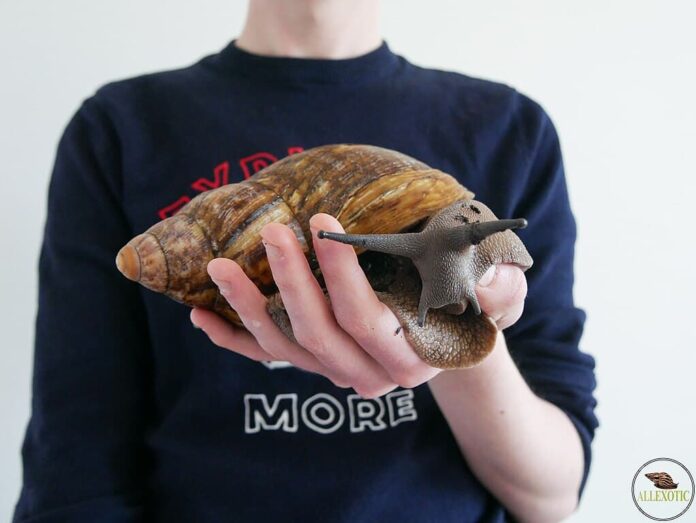
Scientific Name: Archachatina Marginata
Size: 21 centimeters
The giant West African snail or banana rasp snail, is a very large land snail. Some can reach up to 21 centimeters long but the usual size is around 15 centimeters, which is still large. The shell has a brownish color with darker lengthwise stripes, and the color lightens to almost white at the tip. Being one of the largest snail species, it has a bulbous, large, and broad protoconch. Giant Ghana snails occur in Western Africa, from Cameroon to the Democratic Republic of the Congo and the Caribbean. This one feeds on a variety of plants and vegetables, even the economically ones like bananas, lettuce, papayas, peanuts, and peas. Plus the fact that they are the carrier of the parasitic rat lungworm, they are considered an invasive species and pests.
4Giant Whelk
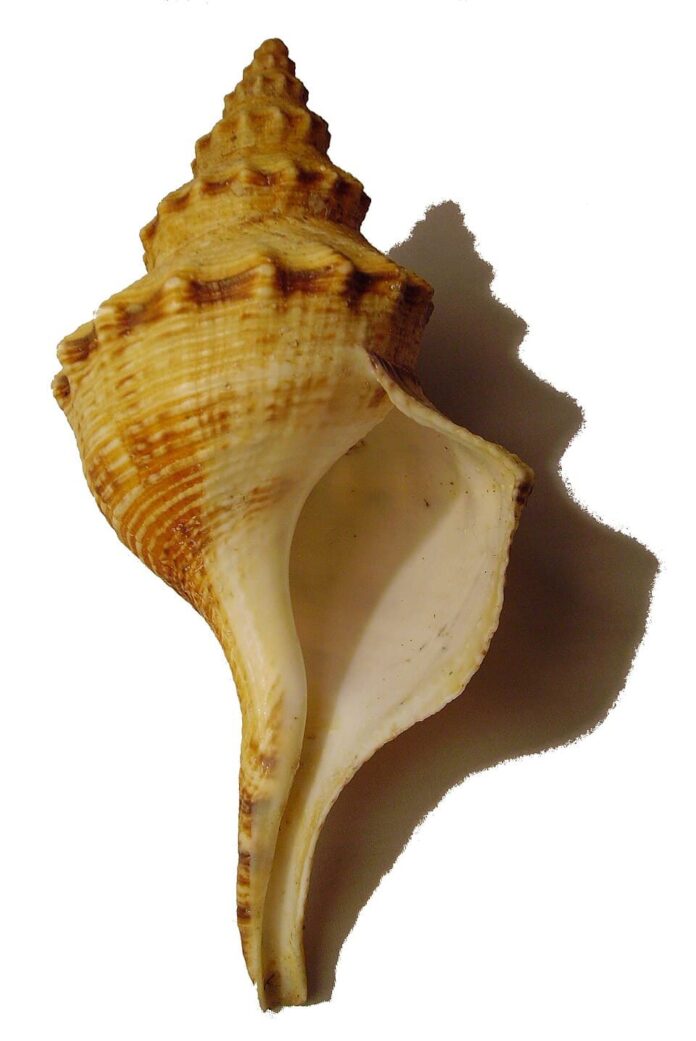
Scientific Name: Penion Maximus
Size: 26 centimeters
While many largest snail species above are terrestrial, the largest of them all are rather in the oceans. For example, the giant whelks are among the largest with a shell size of up to 26 centimeters. A giant whelk has a long siphonal canal with angular nodules on the shoulders of its whorls. These giant mollusks are endemic to Australia, ranging from Tasmania and Victoria all the way to Queensland. They usually live in deep water but the population in Tasmania is commonly found in shallow water. Despite being one of the largest true whelks, there is not much information about these mollusks yet apart from their size.
3Giant Triton
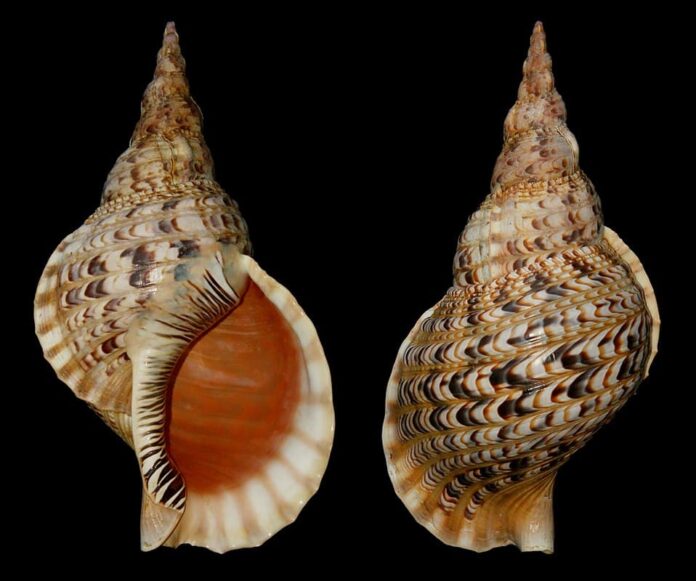
Scientific Name: Charonia Tritonis
Size: 50 centimeters
Giant triton or Triton’s trumpet is a very large sea snail that reaches a size of up to 50 centimeters or even longer. Its shell is typically whiteish with brown and yellow markings while the body is white with brown spots. The shell is very large and solid, and there are steeply spiral ribs on it. Because of their unique appearance and size, these snails are very popular among collectors. People use their shells as a decorative object, and sometimes modify them for use as a trumpet; hence the name. As for the flesh, it is edible but not common because of potential health risks due to the pathogens in their salivary glands.
This marine snail species has a distribution throughout the Indo-Pacific Oceans as well as the Red Sea. In these ranges, the snail inhabits rocky to sandy bottoms where coral reefs are abundant. During the day, a giant triton seeks shelter in crevices and covers the opening with its lid. As the night comes, it emerges to hunt using its sense of smell and vision to locate prey. It lives in lagoons and on reef slopes where it feeds on the crown-of-thorns starfish and cushion stars. This is very beneficial for the reef community because those starfish damage coral reefs. Once it locates the prey, the snail injects the paralytic salivary juices and tears it into pieces with its saw-like teeth. The process of catching and consuming prey can last for up to 3 hours.
2Florida Horse Conch
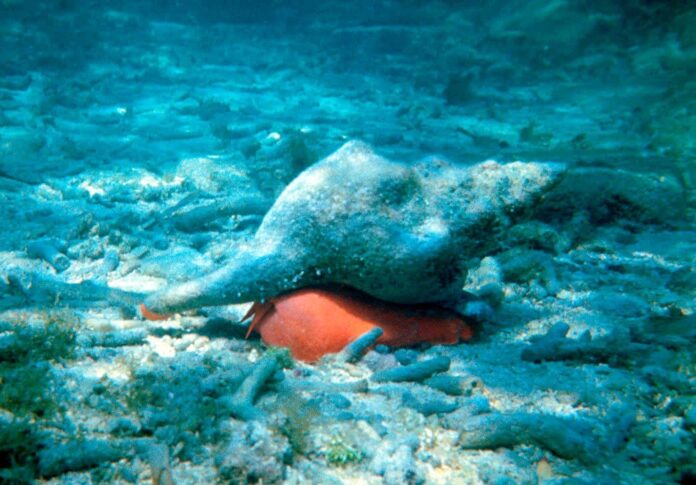
Scientific Name: Triplofusus Giganteus
Size: 60 centimeters
Florida horse conch aka the giant horse conch is well-known to the trophy shell of the state of Florida. As a matter of fact, it is the largest gastropod in the United States waters, with a shell length of 60 centimeters. The shell of the snail is grayish-white to salmon orange, and it has a dark brown or light tan periostracum. And the main feature that you cannot miss is their bright orange-red foot that absolutely stands out. Being a slow-moving creature, it is not uncommon to see a variety of barnacles, bryozoans, and worms on them. This also makes each shell distinct and unique from each other as well.
The distribution of this large snail species is along the Atlantic coast of the Americas, living in tropical and subtropical waters. They dwell on mud flats, sand, and weed from the low intertidal to shallow subtidal zones, looking for other shells to devour. As large predators, they actually prey on other large gastropods like lightning whelks, queen conchs, and tulip shells. When feeding, they use their powerful orange feet to trap and smother their prey before ingesting it. While suffocating the prey, they also excrete paralyzing substances to relax their prey and make the meal easier to consume. Despite being large and ferocious, they still have predators, and those are tiger sharks. Unfortunately, the population of these large snails is declining due to over-harvesting and the rarity of their spawning events.
1Australian Trumpet
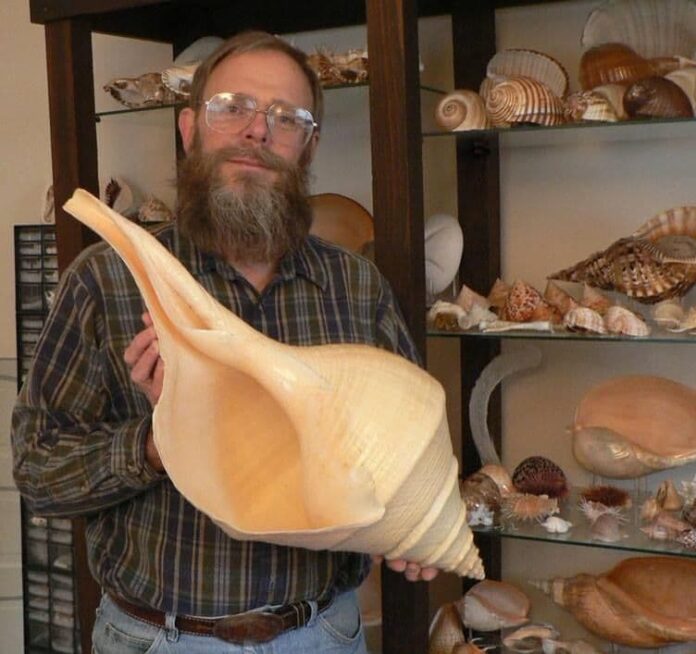
Scientific Name: Syrinx Aruanus
Size: 91 centimeters
Here you are looking at the largest snail in the world, reaching the size of 91 centimeters long. The average length of this large snail species is 75 centimeters, and it can weigh up to 18 kilograms. This snail’s outer case is usually creamy yellow, light beige, or pastel gray with darker spots for easy camouflage. Its robust shell is usually covered with thick brown or gray periostracum while its muscular foot is bright yellow. This shell protects its soft and fleshy structure with a long siphon that the snails use for feeding.
The Australian trumpet is native to Australia, specifically in the northern half of Australia and nearby regions, including Indonesia and Papua New Guinea. Across their range of warm waters, they live on sandy bottoms in the intertidal zone and sublittoral zone. These giants like to burrow in those areas where they hunt for fish, marine annelid worms, mollusks, and small invertebrates. Due to their extraordinary size, shell collectors are absolutely fond of the shells of these marine gastropods. They use the shells as a water carrier, and of course, as a trumpet. At the same time, people also fish for them for their edible flesh as well. Though people don’t overcollect them, but they are facing threats from environmental changes and habitat loss.
Related Post: Colorful Sea Slugs You Should See




